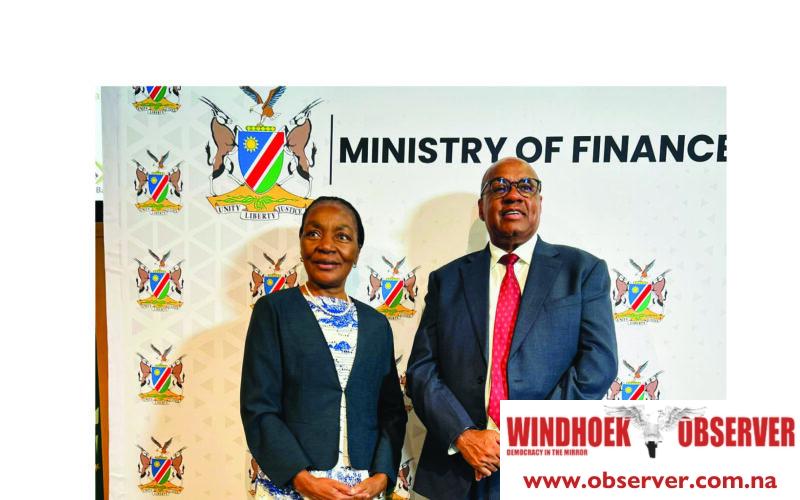Chamwe Kaira
The minister of finance, Ericah Shafudah, says the redemption of Namibia’s US$750 million Eurobond marks a milestone in the country’s economic journey.
On Tuesday, the Ministry of Finance and the Bank of Namibia (BoN) announced that Namibia had successfully redeemed its second eurobond, valued at US$750 million (approximately N$13.9 billion).
The bond represents the largest single debt maturity in the country’s history.
“It is a testament to our unwavering commitment to fiscal discipline, strategic foresight, and prudent debt management,” Shafudah said.
Namibia first issued a eurobond in 2011 under former president Hifikepunye Pohamba at an interest rate of 5.5%.
The funds were used to support projects such as the National Housing Enterprise (NHE) and other development initiatives. That bond was redeemed in November 2021.
In 2015, Namibia returned to the international capital markets with another US$750 million eurobond at a coupon rate of 5.25%. This second bond was redeemed this week.
“Engaging with international capital markets serves as a testament to Namibia’s readiness to navigate its future, reinforcing our confidence as a nation dedicated to sustainable progress. This initiative also underscores the trust placed in our governance, our institutions, and our collective vision for fostering inclusive development,” Shafudah said.
She said the second eurobond helped Namibia bridge key financing gaps, support the national budget, strengthen reserves, and boost economic growth during a period of global financial uncertainty.
The funds were used for major development projects in roads, energy, education and healthcare.
The government implemented the Sovereign Debt Management Strategy of 2005 and the Namibia Financial Sector Strategy (2011–2021), which guide how Namibia sources its funding.
These strategies recommend that 80% of the government’s borrowing come from the domestic market and 20% from international sources.
Shafudah said Namibia has taken a strategic approach by focusing on domestic funding, leading to a stronger local financial market that supports government financing needs.
“The redemption of the Eurobond in FY2025/26 was not only anticipated, it was meticulously planned to follow the principle. Through prudent fiscal management, we established a sinking fund that accumulated the necessary resources to meet our obligations without compromising service delivery or macroeconomic stability. Through this mechanism, we have mobilised US$444 million, demonstrating our resolve to meet obligations,” she said.
To cover the remaining US$306 million (approximately N$5.7 billion), the government invited local commercial banks to participate.
Standard Bank contributed N$3 billion, FNB N$1.5 billion, and Bank Windhoek, in partnership with ABSA, another N$1.5 billion.
“This strategy allowed us to avoid re-entering the Eurobond market under unfavourable global conditions. It preserved our foreign reserves, reduced exchange rate exposure, and reinforced investor confidence in Namibia’s creditworthiness,” Shafudah said.
Foreign reserves are projected to decline from N$63 billion at the end of 2024 to N$47 billion by the end of 2025, with a moderate recovery expected in 2026.
After the eurobond redemption, the government’s debt portfolio will stand at a ratio of 85:15, with domestic debt exceeding foreign debt.
About 90% of Namibia’s foreign debt is denominated in South African rands.
Independent economic and business researcher Josef Sheehama says it is a commendable effort by the Ministry of Finance to redeem the eurobond, as paying back the bond or any debt on time reflects positively on Namibia.
He said the repayment carries significant benefits for all Namibians.
“It improves our creditworthiness. The credit rating agencies are also taking note, which might result in higher ratings or at least prevent negative ratings. If Namibia’s grading is higher, the less we will have to pay interest when we are borrowing in the future,” he said.
Sheehama said the development will also boost investor confidence.
“The other thing that I want to add is that domestic borrowing is also viewed as a strategy and that is to lessen reliance on more volatile foreign loans as well as the currency risk and will also improve our macro stability,” he said.
However, he cautioned that while domestic borrowing has benefits, it requires careful management. He referred to Shafudah’s statement that the government aims for an 85% domestic borrowing ratio and a 15% foreign borrowing ratio.
But Sheehama warned that this approach could have side effects.
“This can drive out investors, raise interest rates and create financial instability,” he said.
He added that the government must clarify how it plans to fund development projects going forward, given its preference for domestic debt funding.
Caption
Minister of Finance, Ericah Shafudah (left) with Bank of Namibia governor, Johannes !Gawaxab following the announcement that Namibia has paid back the eurobond valued at US$750 million (approximately N$13.9 billion).
- Photo: Bank of Namibia




